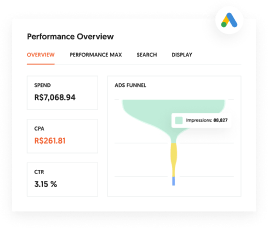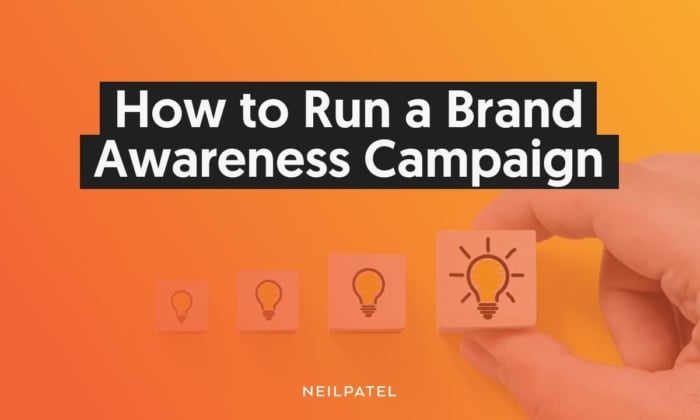
How do you build brand awareness, especially if you’re a new company? Through a carefully crafted brand awareness campaign.
Brand awareness refers to how memorable your brand or company is to your target consumers. It’s how easily people recognize your brand when, for example, they hear your company name or see your logo.
Below, I’ll show you what a brand awareness campaign is and why it matters, and I’ll walk you through the steps to building your own successful branding campaign.
Key Takeaways
- Brand awareness campaigns are not just about visibility, but crafting a presence that resonates with audiences so that they remember and trust the brand.
- Social media engagement, SEO, remarketing campaigns, and advertising across multiple channels and platforms are some typical tactics you can use in brand awareness campaigns.
- You can reach your target audience and increase brand awareness by optimizing your website for search engines and providing valuable content that answers user questions.
What Is a Brand Awareness Campaign?
As Morgan Smith, Digital PR Lead at NP Digital, explains:
“Brand awareness isn’t just about visibility – it’s about crafting a presence that resonates with audiences so that they remember and trust the brand. A successful campaign uses various channels to meet audiences where they are, establishing a cohesive message and a reliable brand presence customers can depend on.”
Basically, you’re trying to ensure your ideal customers have the right impression of your brand, whichever channel they find you on.
One of the best brand awareness campaign examples is the Barbie movie. It redefined brand awareness with experiential marketing and leveraged audience familiarity. For instance, there was the Barbie selfie generator AI tool and Google search queries turned pink when people typed “Barbie” and pink sparkles appeared, too.
Then, of course, there’s the pink Barbie House in the advertising that so many of us remember from our childhood.

Typical tactics used in brand awareness campaigns include:
- 1. Social Media Engagement: Engaging with your audience on social media platforms is a powerful tactic for building brand awareness, increasing customer interactions, and growing your follower base.
- 2. Search Engine Optimization (SEO): Optimizing your website for search engines, conducting thorough keyword research, and providing valuable content that answers user questions helps you reach your target audience.
- 3. Remarketing Campaigns: Remarketing campaigns target individuals who have previously visited your website but did not convert. By using paid marketing tactics to reach this audience again, you can reinforce brand awareness and encourage them to take action.
- 4. Advertising Across Multiple Channels and Platforms: By strategically placing ads across social media, video, display, and programmatic advertising, you can increase the chances of your brand being seen and recognized by a wider audience.
Remember, these tactics are just a starting point, and many other strategies and channels are available for brand awareness campaigns.
Why Should You Create a Brand Awareness Campaign?
Brand awareness campaigns are worth it for three major reasons:
- First, a campaign gives you some control over how people ultimately perceive your brand. Sure, you can’t tell people what to think, but you can certainly promote your brand in a way that nurtures positive associations.
- Brand awareness helps to build trust between you and your target audience. Why does this matter? According to a recent study, trust is the new currency for business. So much so that 71 percent of respondents said they would be unlikely to purchase from a brand that lost their trust. The takeaway? Brand awareness campaigns help you build successful relationships with customers based on trust.
- Trust builds customer loyalty. On the one hand, loyal, happy customers will promote you to their friends and family, which brings you more customers in the long run. On the other hand, over time, your customer acquisition costs will decrease.
Other benefits include:
- Increased recognition
- A competitive advantage
- An emotional connection
As a distinctive brand, you can charge premium prices, too.
Steps to Executing a Brand Awareness Campaign
Are you ready to find out how to run a brand awareness campaign? Here’s what you need to do to kick off your marketing for brand awareness and start building recognition for your brand.
1. Know Your Audience and Where They Are Online
First, you need to know who you’re targeting.
To start, look at your existing customer base. Who buys your products or follows you on social media? Find common traits. Think about what matters to them, pain points, and how your products help them.
Then, do some competitive research. Where else do your customers shop? Who are your biggest competitors?
Finally, analyze your results and create your ideal customer profile. What do you want them to associate your brand with? Your answer will inform your campaign.
Now, you’ve got to pick the right platform. A great brand awareness campaign isn’t just about who you target. It’s about where you target them, too. Where does your ideal buyer hang out? Are they watching videos on YouTube or posting pics on Instagram? Researching your target audience will help you figure this out.
2. Define Success and How to Measure It
Next, set some concrete short-term and long-term goals. Decide:
- What do you want to achieve from your brand awareness campaign?
- How does the campaign fit into your wider, long-term plans for your brand?
- Which strategies will you use to achieve your goal, e.g., PPC ads, social media posts, influencer marketing, etc?
- How you’ll track your progress.
With concrete goals, you can run a campaign with direction and a clear purpose. Every successful marketing strategy begins with a set goal or outcome in mind, so spend time reflecting on what you hope to achieve.
How do you know if your campaign is working? You probably won’t unless you set some criteria for measuring your success.
The metrics you measure vary depending on the marketing strategy used. For example, if you run a campaign on Twitter, you might track things like the number of impressions, shared tweets, and hashtag mentions. If you decide to run paid ads, you could use Google Analytics to track your click-through rate (CTR) and conversions.
You’ll also want to measure website traffic, click-throughs, and branded searches via Google’s Search Console. You can also use social listening or search listening tools like AnswerThePublic.
Monitor your stats and implement strategy changes if necessary.
3. Choose Your Tactics
You want to be where your audience is. Are they watching videos on YouTube, or posting pics on Instagram? Then you need to be there, too.
Other methods you can use are:
Content marketing for brand awareness: With this method, you create and share useful content to inform and entertain your audience. Content marketing can include posting regular blogs, email marketing, infographics, and video content. You could also use audio content, like podcasts.
Influencer marketing: Collaborate with influencers with a strong following and credibility in your industry. For example, Chipotle launched a “Creator Class” for social media influencers.
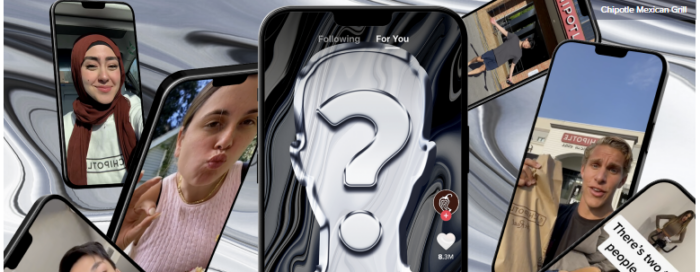
Social media marketing: Use social media platforms to share content, engage your audience, and build community. Share relevant, regular posts and links to content that engage your audience. You can also ask for user-generated content and create a community around your brand.
For example, if you opt for an X (Twitter) campaign, choose a memorable hashtag and get tweeting. Whether replying to tweets, answering customer support messages, or simply liking user-generated content, every communication adds up over time, fostering brand community.
Paid ads: Use display ads, Google Ads, and social media advertising to reach a broader audience. Implement keywords to attract your target audience and ensure you understand search intent.
Press releases: Issue newsworthy press releases and share them via free press release sites to raise your profile and build backlinks. Send them to local and niche media, too.
Other methods you could use are:
- Remarketing (Ad platforms like Google enable you to retarget customers who’ve previously shown an interest in your brand. For example, they may have looked at a specific product on your website.
- Partnerships and collaborations (contact businesses who sell complementary products and ask if they’d consider cross-promotions).
- Event sponsorship (Local events are always looking for sponsors. Consider sponsoring a non-profit event in return for advertising your brand).
Example: Starbucks
As part of its digital marketing strategy for brand awareness, Starbucks is all over social media. It uses a unique approach by building its strategy around the customer experience and uses storytelling to highlight its products and create a connection with its audience.
Here’s an example of its social content:
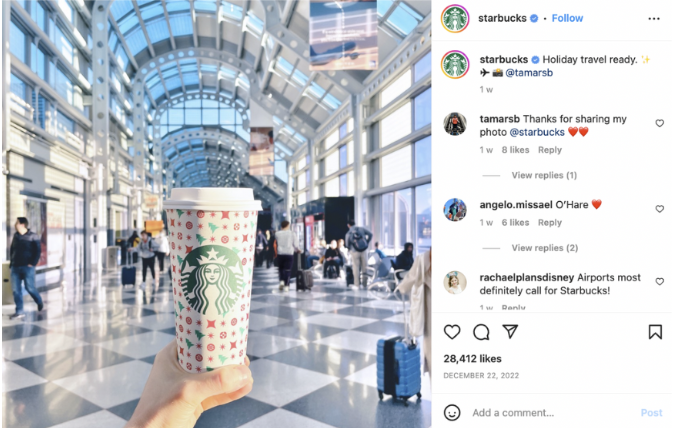
Example: Nike
Nike is another brand that excels on social. Like Starbucks, it has a presence on multiple social media channels. Nike doesn’t go for the straight sell. Instead, it centers on encouraging a healthier lifestyle by using storytelling and impactful slogans to reach its audience.
Additionally, Nike combines motivational content with product promotion, like in this example:
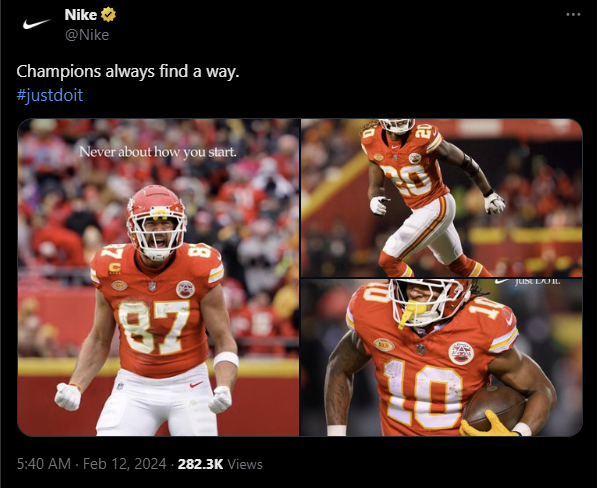
4. Be Authentic and Consistent
Eighty-eight percent of consumers rate authenticity as an important factor when deciding which brands to support. But what makes a brand seem authentic? It’s all about creating a brand voice, showing a personality, and ensuring consistency across all touchpoints.
For instance, Liquid Death embraces its silly side (it’s selling canned water, after all). Traditional marketing methods wouldn’t cut it, so it uses humor in its ads and turns negative comments into promotional opportunities like this:

It even uses mockumentaries and mock ads on sites like YouTube, where its core audience is most likely to find them. It completes its strategy with edgy branding and engaging social media content.
In keeping with its edgy image, its website invites people to “murder their thirst,” mentions “selling your soul” by joining its club, and pledges “death to plastic.”
5. Monitor and Adjust
With your brand campaign up and running, you’ll want to monitor your results. The most important element is engagement.
Your engagement metrics measure how people respond to your marketing to help you understand the customer journey. I’m talking about metrics like conversions, average session duration, page views, and click-throughs with engagement.
Once you’ve analyzed your results, you can use your data to ensure you’re targeting your ideal audience with the right messaging.
If your engagement levels aren’t great, use personalized marketing, work on building a sense of community, and create strong customer relationships. Sometimes, this may mean pivoting from the original strategy you had planned.
Ultimately, engagement, monitoring, and strategic adjustments are essential for a campaign’s success and budget optimization.
FAQs
What Are Brand Awareness Campaigns?
A brand awareness campaign is designed to improve consumers’ awareness of your brand and what it stands for. It should boost your overall recognizability.
Why Should I Create Brand Awareness Campaigns?
Brand awareness campaigns can help you stand out from competitors, improve customer loyalty, and even reduce your customer acquisition costs over time. If you’re looking to grow your business and build customer relationships organically, building a campaign for brand awareness may help.
How Do You Create a Brand Awareness Campaign?
First, set a clear goal and identify your target audience. Then, focus on the platforms where your target audience hangs out the most and work on a few strategies at a time. Engage with followers and make them feel like valuable members of your community.
How Do You Track Your Brand Awareness Campaigns?
You can track your campaign’s performance using analytics tools like Google Analytics. You can also use the metrics tools offered by social media platforms. However you do it, just make sure you’re tracking your campaigns!
Conclusion
A brand awareness campaign allows you to shape how potential customers perceive your company. With the right campaign, you can directly influence what people think when they hear your brand’s name, and you can ensure that customers remember your name for the right reasons!
In other words, it is the backbone of a successful marketing strategy and is surprisingly easy to implement. However, if you’re still a little stuck on how to get started, check out my consulting services.
Have you created a brand awareness campaign yet? Which strategies did you try?

See How My Agency Can Drive More Traffic to Your Website
- SEO - unlock more SEO traffic. See real results.
- Content Marketing - our team creates epic content that will get shared, get links, and attract traffic.
- Paid Media - effective paid strategies with clear ROI.
Are You Using Google Ads? Try Our FREE Ads Grader!
Stop wasting money and unlock the hidden potential of your advertising.
- Discover the power of intentional advertising.
- Reach your ideal target audience.
- Maximize ad spend efficiency.

